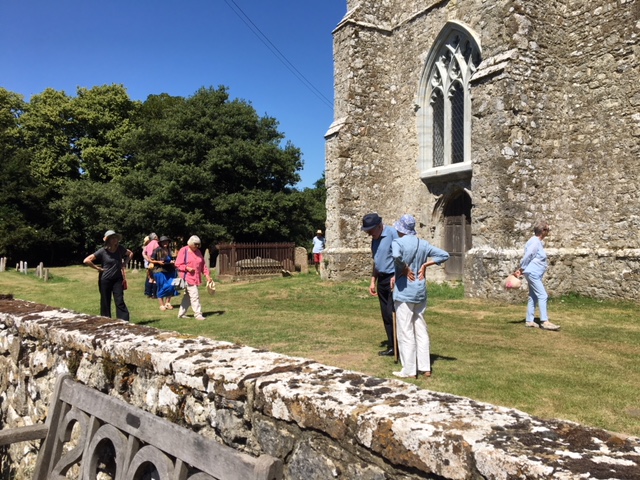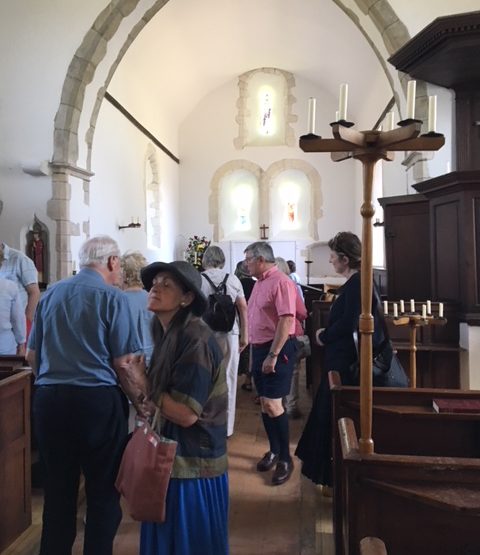Each year the Friends plan a summer outing to visit two or three churches on or around Romney Marsh and then take tea with the Women’s Institute. This year, on June 30, we revisited churches last seen 10 years ago. The visit took place during the period of hot weather. Twenty four Friends met a Rye Community bus and some private cars at Rye Station Approach. I, as Chairman of the Friends, had arranged access to the ancient churches of Ivychurch and Bonnington and would be the guide for the afternoon.

After encountering significant traffic on the Marsh backroads, our first stop was Ivychurch. It became clear later that there had been a major accident on the A2070 involving several cars. This had resulted in a road closure forcing travellers to seek alternative routes across the Marsh. Ivychurch is one of the largest churches on the Marsh and is known as the “Cathedral of the Marsh” because of its size. It is dedicated to St George and is mainly 14th century, but there are remains of an earlier post-Conquest church in the east end. As a church here is also mentioned in the Domesday book, it is likely that there was a Saxon Church, followed by an early post Conquest Church and then the church as seen today.
The building is mainly constructed of Kentish ragstone but some Caen stone from the earlier church can also be found, as can many wave-rolled flints which are a reminder of the proximity of the English Channel. The nave is particularly impressive as it has been empty of seats since the early 1900s when the rotten box pews were removed. The large space created is put to good use for exhibitions, concerts, barn dances and the annual Harvest Supper.

The church is clearly a statement of importance by Archbishops of Canterbury on whose land it was built. Indeed there are signs of links to Canterbury as the blocked windows in the nave are identical to those in the south aisle of Canterbury Cathedral. Perhaps masons from Canterbury were involved with construction at Ivychurch?
After Ivychurch, the Friends headed north across the Marsh to cross the Royal Military Canal and to Bonnington. The route on minor roads enabled those on the bus to see from their elevated position that crops were high and sheep plenty.
Removed from the village, probably because the original settlement around the Church was abandoned after the 14th-century plague, and rebuilt further north, Bonnington St Rumwold is a small two-cell church of great charm. There is a substantial 14th-century rebuild of a much earlier Saxon-Norman church, but the core of the church may date from 796, making it the oldest church on the Marsh.

The building is substantially Norman, with features dating back to the twelfth century. There are three small windows in the east wall representing good Norman work.
The font is from around the time of the Conquest, with a Jacobean cover. On the north side of the chancel arch is a small saint’s niche and above it a bracket which would have the supported the rood screen, probably removed in the 16th century. The north-west window contains fragments of medieval glass, including three heads.
There is a very high gallery at the west end dating back to the Stuart period. It would have been used by local labourers to sing unaccompanied psalms, anthems, chants and hymns. Often early choirs were raucous and fairly independent of the vicar! The elevated position would have accentuated this.
Perhaps to lift the vicar, there was built an enormous Georgian pulpit, with a substantial sounding board. This is quite out of scale in this tiny church. Originally there would have been high box pews, but these have long since been removed.
After Bonnington, there was some enthusiasm to move on to Stone cum Ebony and tea. For those who had experienced a WI tea before there was great expectation of another memorable meal in the wonderful 1914-18 Stone Memorial Hall. On our arrival, the WI team, were ready and waiting with long tables set with plates of sandwiches, scones and cakes. There was the specially badged WI china, which added to a very typical English “high tea” setting. After Stone, the transport threaded its way in bright sunlight to the Military Road and then to Rye.
This was another enjoyable afternoon, for which we must thank John Gurney, Gill and Paddy Harvey for making all the logistic arrangements and Rye Community Transport with Paddy and Lynn Nealon for the safe travel. Facebook: @FriendsOfStMarysChurchRye
Photo: Elizabeth Kimber




Such an enjoyable afternoon. Many thanks to Gill and Paddy Harvey and Anthony Kimber